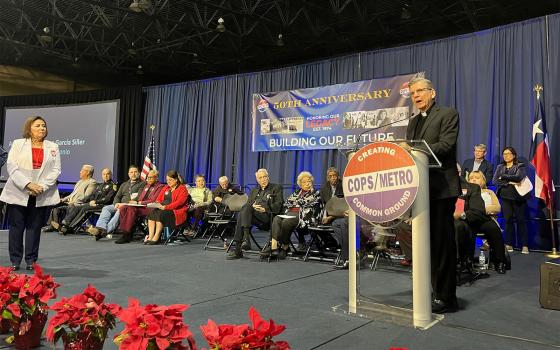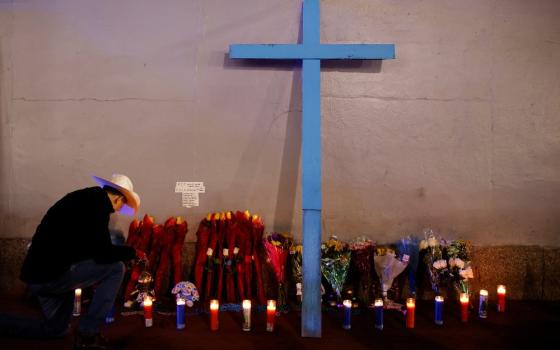The new book “On ‘Strangers No Longer’: Perspectives on the Historic U.S.-Mexican Catholic Bishops’ Pastoral Letter on Migration” is an anthology of essays, looking at that historic pastoral letter from the combined hierarchies from a variety of perspectives. It usefully is published just as the U.S. House of Representatives, among its other challenges, gets ready to figure out what to do on the pressing issue of comprehensive immigration reform.
Normally, I do not like these kinds of anthologies. They can be all over the place and reading them is often like riding a whirl-a-gig at the country fair. This book was well edited, and the point of reference, the pastoral letter, sufficiently in focus, that the text does not spin out of control. More to the point, this kind of book serves a particular purpose in the current political and pastoral context. Over the next weeks, and beyond, the Catholic laity will be drawn into the debate about immigration reform. Pastors will be fielding a variety of questions. Some will want accurate data about the situation of migrants. Others will have theological questions about the Church’s teaching. Others will wonder how this theology can and should inform public policy debates. The answers to all these, and other questions, are usefully contained in this one volume. Every priest should buy a copy and read it. Better, every bishop should buy a bunch of copies, one for each of their priests and ask them to read it. Even if the House were to vote on the issue tomorrow, the debate over immigration will loom large in the 2014 midterm elections and the 2016 presidential election. A priest or lay minister who has read this book will find him or herself prepared to answer almost any question they might be asked on this important topic.
The book opens, as such books should, with a historical look at the issue of immigration, written by Todd Scribner who works at the USCCB. He recalls things I had forgotten and teaches me things I never knew. For example, I did not realize that the Bureau of Immigration was one of the first organizations established by the bishops’ conference, in response to concerns that the anti-Catholic YMCA had been entrusted with the care of immigrants arriving at Ellis Island and elsewhere. The National Catholic Welfare Conference (NCWC), as the bishops’ conference was then known, hired a director based in Washington and sub-directors for each of the major ports of entry on the East Coast. A couple of years later, in 1923, the Bureau expanded its activities into the Southwest, opening an office in El Paso. I also did not know that one of my heroes, Msgr. John A. Ryan, was wrong on this issue, supporting a literacy test for immigrants for fear of the depressing effect it would have on wages if large numbers of low-skilled workers came to our shores. I was also delighted to learn that as early as a 1924 letter to a key member of Congress, Father John Burke, the General Secretary of the NCWC, was not afraid to call a quota bill “distinctly un-American.” Nativist policies, before and since, have earned that usually coarse and hoary designation. And, finally, the bishops’ stance on the McCarren-Walter bill in 1952 – which they supported in the end despite its many deficiencies – would have served the bishops well as a model of how to craft their position on the Affordable Care Act. Legislation is never the realm of the perfect.
Fr. Allan Figueroa Deck, S.J. of Loyola Marymount University has a chapter that considers the pastoral contexts of the immigration issue. Deck details how the immigrant community is bringing new life to our Church. For example, almost a third of the diocesan priests in Orange County, California, are of Vietnamese origin, and Vietnamese men and women represent a significant number of new women and men religious. He notes that already, Hispanic and other immigrants are moving beyond pastoral leadership of their own ethnic community and assuming broader leadership roles. He calls this process “moving out of their silos.” Deck does not want this process of moving out of the silos to facilitate a bland multiculturalism which, as the bishops noted in another document, “This [multicultural] model often dilutes the identity and vision of Hispanic ministry and those of other ethnic ministries.” Deck is too polite to say it, but I will: Multiculturalism is a conceptual goal that only successful white folk could devise.
One of my favorite chapters comes from Notre Dame’s Daniel Groody, who examines the theological perspectives of “pilgrim people” and how that should inform our consideration of immigration issues. Groody brilliantly flips the standard conceptual ideas with which many people approach the issue of immigration:
Strangers No Longer reminds us that to limit compassion to the borders of one’s nationality, one’s family, or even one’s self is a migration towards disintegration. For those on a trajectory toward disintegration, a theology of migration cannot make sense, sine it will always be news from a foreign land. In the term “alien” is to be used at all, it would be descriptive not of those who lack political documentation but of those who have so disconnected themselves from God and others that they are incapable of seeing in the vulnerable stranger a mirror of themselves, a reflection of Christ, and a challenge to human solidarity.
That is just brilliant, yes?
There are specialized chapters, such as one on human trafficking and another on the DREAM Act and those who would benefit from it. My colleague at Catholic University’s Institute for Policy Research & Catholic Studies, Maryann Cusimano Love looks at the evolving treatment of refugees, reminding us that the face of a refugee is usually a female face. Mark Ensalco looks at the relationship between the bishops’ teaching authority and public policy advocacy, and the role of the laity, pointing out that Strangers No Longer is not only a plea from the bishops seeking protection for their flock, but a call to justice for all.
The final chapter should be read by anyone whose vocation is in the political and civic field. There, J. Kevin Appleby looks at the recent political landscape. I say “recent” but it appears this chapter was written before the 2012 election results moved immigration reform up the ladder of political priorities for both parties. I remember within days of Obama’s re-election triumph listening to Sean Hannity announce that he had seen the light on this issue and was prepared to support comprehensive reform. Appleby reminds us that we have been close to success before, but that powerful interests and ideological beliefs can derail reform efforts. He tells a sobering tale and in the struggle to get immigration reform through the U.S. House, we will need to be sober. We can celebrate after! Appleby also responds to those who have wrongly – and stupidly – criticized Archbishop Jose Gomes, who leads the USCCB Committee on Migration, for reaching out to conservatives. Hello? Those are the people we need to persuade and, to my mind, Archbishop Gomez never looks more persuasive on this issue than when he has a labor leader on one side of his and a business leader on the other.
This book is not light beach reading, but summer is over and there is work to be done. Scribner and Appleby have provided the Church with a resource for the upcoming debate and the consequent fallout once the House votes. Again, this book should be found on every rectory bookshelf, well dog-eared. It contains gems that lighten the seriousness of the topic. More importantly, it helps all Catholics grasp exactly why this issue is so important to us as Catholics, that the debate about immigration is not only about the immigrants, it is about us who are already here and what kind of nation we wish to be.




